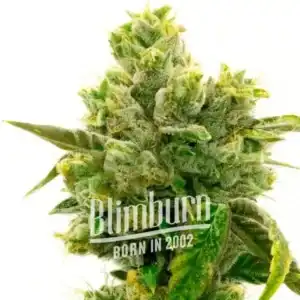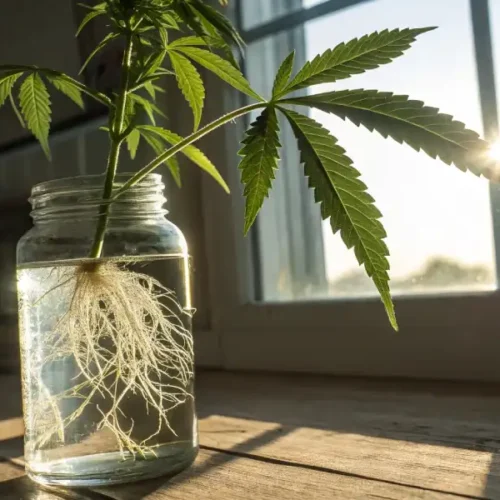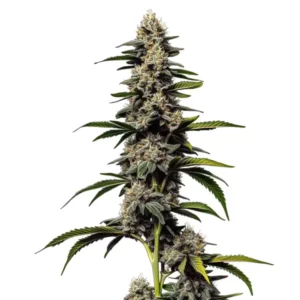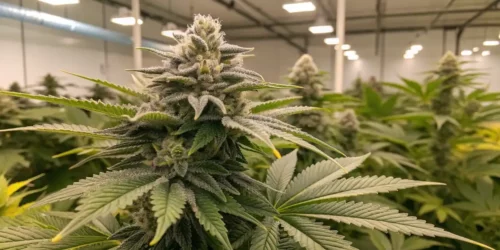When it comes to cultivating cannabis, optimizing light intensity during the flowering stage is crucial for maximizing yields and potency. However, determining when to increase light intensity in flowering can be a bit tricky. In this comprehensive guide, we’ll delve into the various factors to consider and provide actionable insights on when and how to ramp up light intensity for your flowering cannabis plants.
Factors that influence the intensity of lighting during flowering
Before diving into when to increase light intensity, it’s essential to understand the factors that influence how much light your cannabis plants need during the flowering stage.
Recommended Strains
Fat Bastard
 THC: 30% - 38%
THC: 30% - 38% Type of seed: Feminized
Type of seed: Feminized Phenotype: Mostly Hybrid
Phenotype: Mostly Hybrid Day to flower: 8 - 10 weeks
Day to flower: 8 - 10 weeks
Fat Bastard Auto
 THC: 30% - 38%
THC: 30% - 38% Type of seed: Autoflowering
Type of seed: Autoflowering Phenotype: Mostly Hybrid
Phenotype: Mostly Hybrid Day to flower: 8 - 10 weeks
Day to flower: 8 - 10 weeks
1. Strain Genetics
Different cannabis strains have varying light requirements during flowering. Some strains thrive with higher light intensities, while others may be more sensitive and require lower levels.
2. Growth Environment
Factors such as temperature, humidity, and CO2 levels can impact how efficiently cannabis plants utilize light. An optimal growth environment ensures that plants can make the most of increased light intensity.
3. Stage of Flowering
The lighting needs of cannabis plants evolve throughout the flowering stage. The specific requirements during each phase is essential for achieving optimal results.
Promos & Deals
How to progressively increase the lighting power
Now we will see an example of how we can enhance the lighting in our plants while their cultivation stage progresses. For example, if we start during the vegetative stage, with lights of 300 with the proper schedule of 6/18. We may expose plants progressively to increasingly higher light levels, ensuring a gradual transition to avoid any shock.
When we transition to the flowering stage it initially involves a change to 600-watt lights on a 12/12 schedule. We maintain this intensity for about 10 to 14 days, that is, during the pre-flowering phase, when the plants present their sex and start. produce the first pistils that will later transform into buds.
Upon completion of two weeks, you can supplement with 600 watts, in week 3, we raise the intensity to approximately 825 watts. This adjustment coincides with the post-vegetative stage of advanced plant growth, which allows us to observe their response to increased lighting.
The most significant light intensity adjustments occur between the middle of Week 3 and the end of Week 6, that is, when the plant is in full flower, producing buds at maximum capacity. During this period it is increased from 900 to 1100 watts, taking into account factors such as the number of lights, the size of the room and the distance of the light from the plants. . This period, spanning from week 3 to week 6, marks the most substantial growth phase. We say that the plants grow because when they produce buds and fill up, their lateral size can even double, taking up much more space in the growing area.
This example that we show you can also be applied with lower power bulbs, for example starting with 150w halide bulbs and then increasing the power. It can also be applied if you grow with LED lights and focus on optimizing led light intensity during flower to achieve better results.
Reasons why progressively increasing lighting is essential.
Minimal light intensity is recommended during the initial two weeks of the growth cycle. Transitioning from an 18/6 to a 12/12 light cycle is a significant change for plants and induces a certain level of stress. Therefore, it’s advisable not to add further stress by significantly increasing light intensity. A modest increment suffices.
During these initial weeks, plants tend to stretch and exhibit growth patterns more characteristic of the vegetative stage rather than flowering. Hence, excessive light intensity isn’t necessary, as the shift in light schedule alone triggers the post-vegetative stretch. Consequently, only a slight increase in intensity is required.
The period from Weeks 3 to 6 is crucial, as this is when plants experience the most significant growth in maturity, particularly in bud development. Optimal light intensity is vital during this phase to support robust bud development, density, and overall bud size, including lower branches and top colas. Weeks 4, 5, and 6 are especially pivotal for maximizing growth.
In Weeks 7 through 9, it’s advisable to gradually decrease light intensity. Although plant size may not increase substantially beyond Week 6, flower quality continues to improve, with aromas and colors deepening. Emulating the natural progression of seasons, reducing light intensity mimics the diminishing daylight of fall, aligning with the approach of lowering temperatures towards the end of the flowering cycle. Gradually increasing light intensity to avoid shocking plants, peaking intensity during prime flowering stages, and then gradually reducing it as flowering completes.

Conclusions and ask on increasing lighting.
Our experience indicates that plants exhibit superior response, displaying robust health and vigor in the first few weeks of flowering and experiencing significant growth during the mid-flowering stage.
When to increase light intensity in flowering is necessary, we have observed greater plant growth. Additionally, bud development has improved significantly, contrary to our initial concern about smaller, less dense buds. Instead, we’ve gotten larger, denser buds that are remarkably solid. Surprisingly, this approach has resulted in substantially higher overall returns.
Do plants grow faster with higher light intensity?
Yes, cannabis plants tend to grow faster with higher light intensity. Light is one of the most important factors for plant growth, since it triggers the process of photosynthesis, through which plants convert light energy into chemical energy, necessary for their growth and development.
However, it is important to note that there is an optimal light intensity point for cannabis plants, as too much light can cause plant damage, leaf burn, or stress. Therefore, it is essential to provide an adequate amount of light, controlling both the intensity and duration of the light period to maximize the growth and health of cannabis plants. Besides, other factors such as temperature, humidity and quality of the substrate also influence the growth of cannabis plants.
What LED lights are best for cannabis?
When it comes to optimizing cannabis growth, the best LED lights to consider are those specifically designed for horticulture. LED grow lights tailored for cannabis cultivation offer the ideal spectrum and intensity necessary for robust plant development and higher yields. Knowing when to increase light intensity in flowering indoor is crucial, as full-spectrum LED lights with adjustable settings allow growers to fine-tune lighting during each stage, especially flowering. Ensuring optimal photosynthesis and cannabinoid production at the right time can significantly enhance both the quality and quantity of your cannabis harvests.
Full spectrum cannabis growing lights offer a wide range of technical qualities designed to maximize the growth and health of cannabis plants. These qualities include:
Optimal Spectrum: Full spectrum lights emit a variety of wavelengths that mimic sunlight, providing cannabis plants with the light needed for all stages of growth, from germination to flowering.
Adjustable Spectrum: Some full spectrum lights allow you to adjust the intensity and spectrum of the light emitted, allowing you to adapt to the specific needs of plants at different stages of growth.
Energy Efficiency: Full spectrum LED lights are highly efficient in terms of energy consumption, making them more economical to operate in the long term compared to other light sources such as high-pressure sodium (HPS) lamps.
Low Heat: Full spectrum LED lights generate less heat compared to traditional lighting technologies, helping to keep temperatures within the growing area under control and reducing the need for additional cooling systems.
Long Lifespan: Quality LED lights have a significantly longer lifespan than other lighting options, meaning less need for replacement and reduced maintenance costs over time.
Cannabinoid-specific spectrum: Some full-spectrum lights are designed with a particular focus on wavelengths that promote the production of cannabinoids and terpenes, which can improve the quality and potency of your cannabis harvest.

What is the best intensity for growing lights?
Experts suggest that maintaining a light intensity of at least 1800 micromoles is optimal for hemp cultivation, ensuring maximum value for your plants. Beyond this threshold, however, the efficiency of light absorption diminishes. It’s important to note that while cannabis thrives under intense light, excessive exposure can lead to phototoxicity, evidenced by leaf burning or curling.
While increasing light intensity up to 1000 micromoles results in proportional yield increases, pushing beyond 1800 micromoles risks inhibiting photosynthesis and causing plant damage. Therefore, striking the right balance is crucial for maximizing yield and plant health.
What is the best light height for flowering?
The optimal height for your LED grow light depends on various factors, such as the light’s overall intensity and the maturity of your plants, alongside the temperature of their leaves.
Consequently, here are the recommended hanging distances for non-dimmable LED grow lights:
- Position your LED grow lights between 20″ to 30″ above seedlings.
- As your plants enter the vegetative stage, adjust the LEDs to approximately 18″.
- For enhanced trichome production during flowering, consider lowering the LEDs to 16″.
These suggested heights serve as a general reference. The intensity of your LED grow light may influence how close you can place these lights to your plants. Additionally, ensure that the temperature of the plant leaves remains below 30 degrees Celsius.
Refer to the recommended heights provided by the LED manufacturer for the most suitable setup of your grow room. If feasible, utilize a PPFD scanner to measure the average PPFD your plants will receive across your growing area.
Does light intensity affect bud size?
Apart from photosynthesis, the level of light also plays a significant role in shaping the structure and appearance of cannabis plants. If the light intensity is inadequate, it can result in elongated, feeble stems and scarce foliage, which can have a detrimental effect on the overall harvest. Conversely, when the light intensity is optimal, it fosters dense, robust growth and plentiful bud development, thereby improving the final cannabis yield.
What color light is best for bud cannabis growth?
Most experienced and studious growers know that the 660 nm wavelength, commonly known as red light, plays a crucial role in the growth of cannabis plants by boosting their energy production. Increased exposure to red light accelerates plant growth, especially during the germination and flowering phases. The addition of red light promotes robust flowering and budding.
As cannabis plants approach flowering, growers often increase the intensity of red light. However, excessive red light can cause plants to stretch out and become too tall, resulting in reduced yields and elongated, unstable growth. To counteract this, it is important to provide a balanced combination of colors such as red and blue, for optimal plant development. Many growers use LED lights that can be adjusted to provide the right combination of light spectrums for each stage of growth.

Sweet Island Skunk Fast Version
This hybrid, boasting up to 19% THC content, offers effective daytime relief for minor aches, arthritis, nausea, and loss of appetite. Sweet Island Skunk Fast Version not only uplifts mood but also serves as a remedy for depression, anxiety, and stress. Users commonly experience enhanced focus and creativity, alongside potential relief from migraines, fatigue, and nerve pain. The Sweet Island Skunk has been grown on Vancouver Island in British Columbia, Canada, for many years. High Time listed these genetics among the 10 best of 2013.
In terms of cultivation, Sweet Island Skunk Fast Version proves more manageable compared to many other Sativa-dominant strains. It thrives particularly well in a Screen of Green setup, exhibiting robust growth indoors. However, due to its height and space requirements, outdoor or greenhouse cultivation may yield better results. Throughout its eight to nine-week flowering phase, plants will require support, potentially yielding over 200 grams for growers. Outdoor harvesting typically occurs by mid-October.
In this version of Sweet Island Skunk Fast Version , you will find quick-growing plants that do not require greater conditions such as more light power, in indoor crops and that provide all the qualities of their feminized version, but in a super short flowering time. since they only require 7 to 8 weeks.
Alaskan X Kush X Brazil
The Alaskan X Kush X Brazil genetic strain is the result of a meticulous cross between three cannabis varieties with distinctive characteristics. Each of these parent strains brings their own unique qualities, which combine to create a unique and complex drinking experience. Alaskan is known for its resistance to harsh climates and high THC content, suggesting that offspring can inherit these robust and potent traits. On the other hand, Kush, a legendary strain, is famous for its deep relaxing effect and earthy, spicy aroma, which could add a dimension of physical relaxation and flavor to the mix. Finally, Brazil, with its tropical origins, can provide nuances of fruity flavor and an uplifting energy, thus balancing the sedative influence of the other two strains.
The combination of these three strains in Alaskan X Kush X Brazil promises an intriguing and multifaceted drinking experience. From the moment it is inhaled, users can expect an explosion of complex flavors ranging from earthy and spicy notes to fruity and sweet undertones. This synergy of flavors is complemented by an effect that encompasses the best of each parent strain: an initial feeling of euphoria and energy followed by a deep, calming relaxation. This balance between brain and body effects makes this strain ideal for a variety of situations, whether relaxing after a long day or stimulating creativity and sociability in a social setting.
In terms of its growing characteristics, Alaskan However, it may also require specific care to optimize its resin production and potency. With a flowering period that varies depending on growing conditions and specific phenotype, growers can expect a vigorous, high-yielding cannabis plant that rewards proper attention and care with dense, resinous buds.
Lemon Tree x Zkittlez
Lemon Tree x Zkittlez , a delightful hybrid cannabis strain that tantalizes the senses with its irresistible combination of flavors and effects. This exquisite strain is the result of crossing two beloved varieties: Lemon Tree and Zkittlez.
Lemon Tree, a multi-award-winning strain, bursts onto the scene with its intense lemon aroma, underscored by hints of diesel inherited from its Lemon Skunk and Sour Diesel lineage. The plump buds of Lemon Tree evoke images of actual lemon trees, promising a sensory journey with every puff.
On the other hand, Zkittlez, a hybrid sensation, captivates users with its sweet and fruity profile, a delightful fusion of grape candy, berries, citrus fruits, and tropical notes. With accolades such as the 2015 Cannabis Cup in San Francisco for Best US Hybrid Concentrate, Zkittlez brings a rich genetic heritage blending Grape Ape and Grapefruit strains.
Combining the best of Lemon Tree and Zkittlez, Lemon Tree x Zkittlez offers a symphony of flavors and effects. THC levels typically range between 17 and 25 percent, ensuring a potent experience for users. Its hybrid nature means it can induce both indica-style relaxation and sativa-driven euphoria, providing a versatile high that caters to various preferences.
Consumers of Lemon Tree x Zkittlez report experiencing a gentle euphoria coupled with physical relaxation, making it ideal for alleviating tension and discomfort. The strain’s clear-headed effects promote focus and confidence, allowing users to engage in daily activities with ease. Additionally, its reputed ability to combat fatigue and manage various discomforts adds to its appeal among cannabis enthusiasts.
Whether you’re seeking a burst of citrusy delight or a soothing relaxation session, Lemon Tree x Zkittlez promises an unforgettable experience that combines the best of both worlds. So, indulge your senses and elevate your cannabis journey with this exceptional hybrid strain.
FAQs of when to increase light intensity in flowering
When should I increase light intensity during the flowering stage?
You should begin increasing light intensity around the third week of flowering, after the initial 10–14 days of the pre-flowering phase. This is when cannabis plants start focusing energy on bud development. Gradually raising light levels during weeks 3 to 6 ensures dense bud formation and maximized yields without shocking the plants.
Why is gradually increasing light intensity important during cannabis flowering?
A gradual increase in light intensity helps cannabis plants adapt without stress. During the shift from vegetative to flowering (typically from 18/6 to 12/12 light cycles), plants undergo significant hormonal changes. Ramping up light intensity too quickly can lead to light burn, stunted growth, or reduced bud quality. Gradual adjustments support healthy flowering and larger buds.
What factors affect how much light intensity I need in flowering?
Several factors influence optimal light intensity during flowering, including strain genetics, growth environment (temperature, humidity, CO₂ levels), and the flowering stage itself. For best results, monitor these conditions and increase intensity in sync with your plant’s development. Tools like a PPFD meter can help you achieve ideal lighting levels.


















